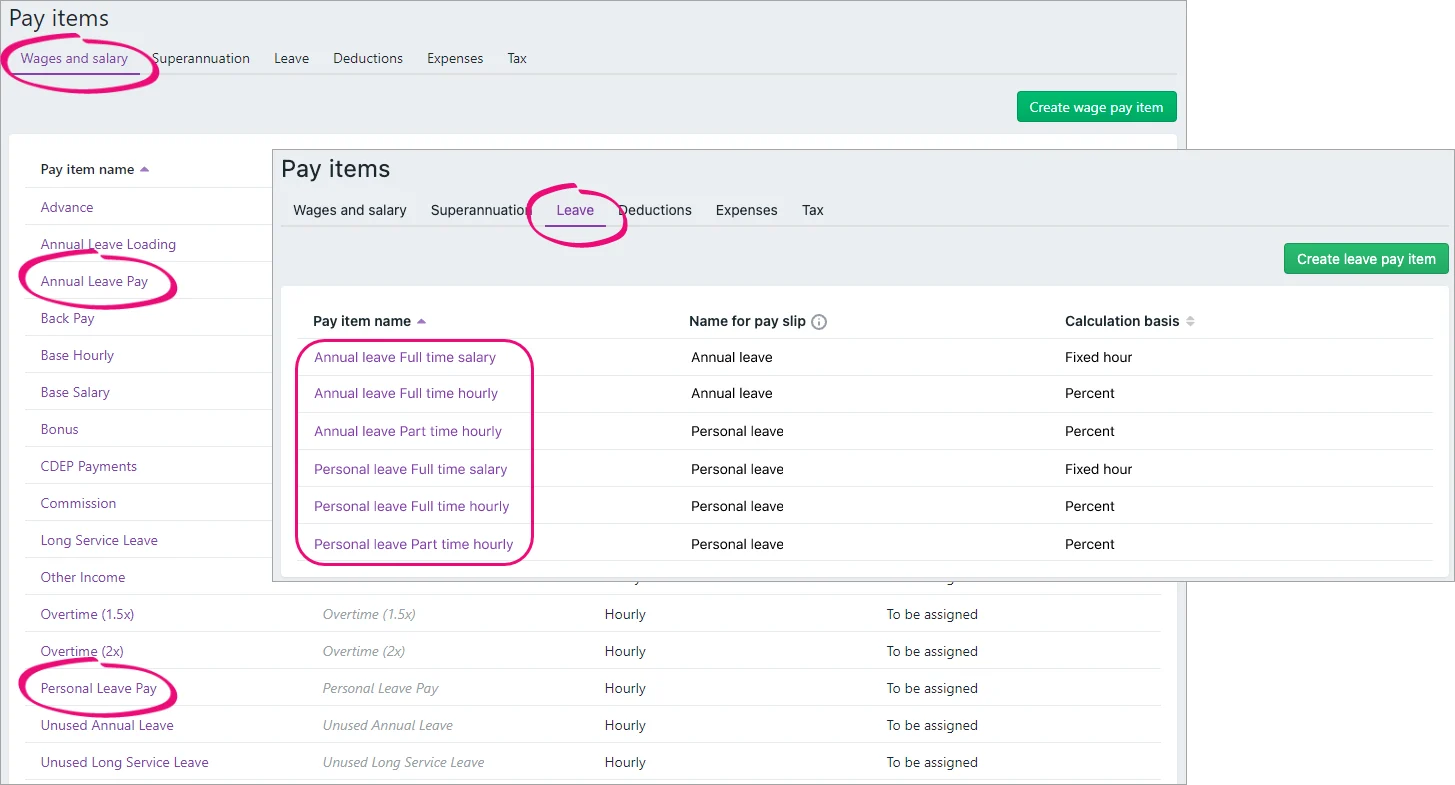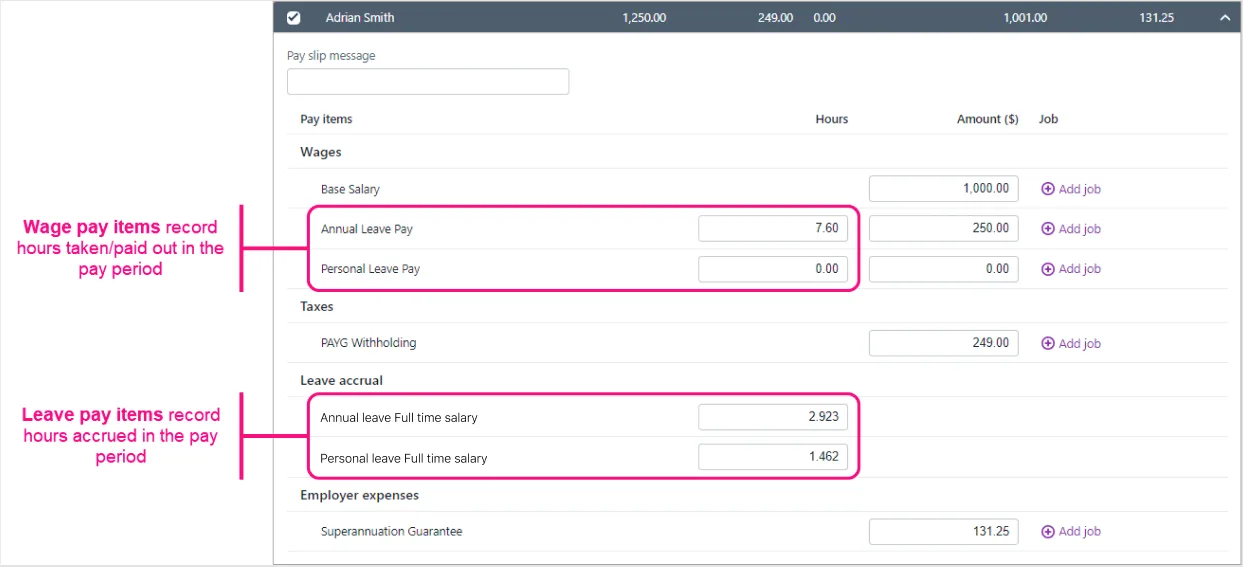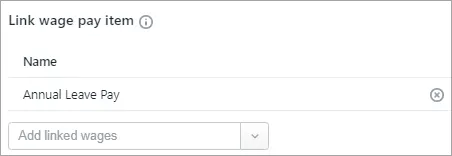Most employees are entitled to a certain number of days of leave that they can take during the year. This might include annual leave, personal leave (sick leave), bereavement or compassionate leave, or carer's leave. Regardless of the name, MYOB handles all leave in a similar way.
If you're not sure what leave your employees are entitled to, the Fair Work website is a good place to start.
How leave works in MYOB
There are 2 parts to leave:
the leave balance (how much leave is available to be taken), and
the leave payment (how much is paid when leave is taken).
MYOB uses leave pay items to track your employees' leave balance. The payment of leave is handled using a wage pay item. So when an employee takes leave, the wage pay item looks after the payment and the leave pay item keeps track of their leave balance.
To help manage your employees' leave, MYOB comes with some default pay items (Payroll > Pay items):
2 wage pay items – to pay for annual leave and personal leave payments and to reduce the employee's leave balance
6 leave pay items – to calculate and maintain the accrued leave for different types of employees

Don't see all these default pay items?
If you've been using MYOB for a while, you might see fewer default pay items. But you can create new pay items to suit the needs of your business – see below.
Once the applicable pay items are assigned to an employee, you can pay them for leave – like this example:

In the above example, an employee is taking 7.6 hours of annual leave in the pay period, and this is entered against the Annual Leave Pay pay item . The Annual Leave Accrual leave pay item shows the number of hours the employee is accumulating over the pay period (2.923 hours).
Need to fix some leave? See Managing your employees’ leave. What about unpaid leave? See Leave without pay.
To assign annual leave and personal leave to your employees
From the Payroll menu, choose Pay items.
Click the Wages and salary tab.
Click to open the Annual Leave Pay pay item.
If it hasn't already been chosen, choose the applicable ATO reporting category. If unsure, check with your accounting advisor or the ATO. Learn more about assigning ATO reporting categories for Single Touch Payroll reporting.
Under Employees using this pay item, choose the employees who are entitled to annual leave.
When you're done, click Save.
Click the Leave tab.
Click to open the annual or personal leave pay item you want to assign. Choose the one that matches the employees you're assigning it to (full time, part time, salaried or hourly).

Under Employees using this pay item, choose the employees who are entitled to annual leave.
Click Save.
Repeat the above steps to assign the Personal Leave wage and leave pay items to your employees.
Linking wage pay items and adding exemptions
MYOB's default leave pay items are set up to suit most businesses. But if you've created additional wage pay items, you might need to choose additional linked wage pay items or add additional exemptions. To learn more see Linking a wage pay item and adding leave exemptions.
To create a wage pay item for paying leave
If you have other types of leave that you need to pay your employees (apart from annual and personal leave) you'll need to set up a wage pay item for it.
Remember – wage pay items are used to include payments on an employee's pay.
Go to the Payroll menu and choose Pay items. The Pay items page appears.
Click the Wages and salary tab
Click Create wage pay item.
Enter a Name for the new pay item.
If you'd like a different, more personalised, name to show on pay slips for this earning, enter a Name for pay slip, such as "Saturday rate - Steven". If you leave this blank, the pay item Name will display instead.
Choose the ATO reporting category for this wage. If you're not sure, check with your accounting advisor or the ATO. Learn about assigning ATO reporting categories for Single Touch Payroll.
For the Pay basis, choose Hourly. This is applicable for both salaried and hourly-based employees.
Choose whether the pay rate is:
Regular rate multiplied by—choose this option if the pay rate is to be calculated on the employee's regular pay rate. Enter the multiplier in the next field. So if you were setting up double time overtime, you'd enter 2 here.
Fixed hourly rate of—choose this option if the pay rate is the same amount each pay. Enter the hourly rate in the next field.
(Optional) Select the option Automatically adjust base hourly or base salary details if you'd like the base hourly or base salary hours and amounts to be adjusted for amounts paid using this new wage pay item.
(Optional) If you have a specific account that you want to use to keep track of payments made using this pay item:
Select the option Override employees' wage expense account.
Choose the applicable Wage expense account. How do I create accounts?
Under Allocated employees, choose the employees to be assigned this wage pay item. To remove an employee, click the delete ( ) icon for that employee.
Under Exemptions, choose any deductions or taxes that shouldn't be calculated on this wage pay item. If you're not sure, check with your accounting advisor or the ATO.
When you're done, click Save.
To create a leave pay item for accruing leave
If you have other types of leave that your employees will accrue (apart from annual and personal leave) you'll need to set up a leave pay item for it.
Remember – leave pay items are used to track the leave an employee has accrued.
Go to the Payroll menu and choose Pay items. The Pay items page appears.
Click the Leave tab
Click Create leave pay item.
Enter a Name for this leave.
Choose the Calculation basis.
User-entered amount per pay period - Select this option if you want to enter the hours to accrue in each employee’s standard pay, or manually enter hours accrued when recording the pays.
Equals a percentage of wages - Select this option if your employees are paid on an hourly basis or work variable hours.
You'll need to specify a percentage rate, which will be multiplied by the hours worked in the pay period, to determine the number of leave hours accrued.
Select the pay item to base the calculation on from the Percent of selection list. We suggest you select the Gross Hours option and then use the Exemptions below to choose the pay items you don’t want the entitlement to accrue on.
For example, say your employees work a 38 hour week, and occasionally work overtime. You need to exempt any pay items that are paid in addition to the employee’s standard 38 hour working week, such as overtime hours, holiday leave loading. But don’t exempt pay items that are paid instead of their normal hours, such as annual leave or personal leave, otherwise the accrual will not calculate correctly.The National Employment Standards specify that as a minimum, full-time and part-time employees get 4 weeks of annual leave, based on their ordinary hours of work. Also, the minimum personal leave entitlement is 10 days per year for full-time employees, or pro rata of 10 days for part-time employees, depending on their hours of work.
If your employees are entitled to:
-
4 weeks annual leave per year (or pro-rata for part-time employees), use the percentage 7.6923%
-
10 days personal leave per year (or pro-rata for part-time employees), use the percentage 3.8462%
Have more questions about minimum leave entitlements? See the Fair Work website.
-
Equals dollars per pay period - Select this option if your employees are paid a salary.
To calculate the correct number of entitlement hours, you need to specify a fixed rate that should be accrued each Pay Period, Month or Year, regardless of the hours worked by the employee. No matter which option you choose, the total hours accrued per year will be the same, so choose the calculation that’s easiest for you to work out.Example:
Say your employees are entitled to 4 weeks annual leave per year, and they work a 7.6-hour day (38-hour week). You would enter:
-
152 hours per year (4 weeks x 38 hours) or
-
12.67 hours per month (152 hours / 12 months) or
-
the rate per pay period, which you calculate by dividing the entitlement hours by the number of pay periods. For example, if your employees are paid fortnightly, you would enter 5.846 per pay period (152 hours / 26 pay periods).
-
(Optional) If you don't want the balance of this leave to show on employee pay slips, deselect the option Show leave balance on pay slips.
(Optional) To carry over accrued leave into the next payroll year, select the option Carry remaining leave over to next year.
Under Link wage pay item, select one or more wage pay items.
What is this?
Each leave pay item must be linked to at least one wage pay item. Select the pay items that you’ll use to record the hours taken by employees for this leave. When recording a pay for an employee who has used this leave type, for example, by taking a holiday, you allocate the hours taken using the linked wage pay item, and the employee’s accrued leave balance will be automatically reduced.
For example, when setting up a Personal Leave pay item, you could link the Personal Leave Pay and Personal Leave Pay (No Cert) wage pay items (or whatever pay items you've set up for this purpose). When an employee takes some personal leave, the Personal Leave accrual balance is reduced by the hours you enter in those linked wage pay items.Learn more about linking wage pay items.
Under Employees using this pay item, choose the employees who are entitled to this leave. To remove an employee, click the delete icon for that employee.
Under Exemptions (if the Calculation basis you chose at step 5 is Equals a percentage of wages), choose all wage pay items that should not accrue this leave. If you're not sure, check with your accounting advisor or the ATO. Learn more about adding exemptions.
When you're done, click Save.
To enter opening leave balances
When you add an employee into MYOB, if they have already accrued leave in your previous payroll system you can record their opening leave balance.
Here's what to do:
Go to the Payroll menu and choose Employees.
Click the employee's name.
Click the Payroll details tab.
Click the Leave tab. The leave pay items the employee is entitled to should be listed. You can add or remove pay items here if needed.
Enter the employee's opening leave balances in the Balance adjustment column for each applicable leave pay item.
When you're done, click Save.
Repeat for all other employees with opening leave balances.
What now?
Once you've set up your employees' leave, you can include leave in their pays. Find out about Paying leave.
FAQs
How do I get leave balances to reset at the start of the payroll year?
If you use a type of leave where the balance of leave doesn't carry over into the next payroll year, you can prevent it from doing so.
Go to the Payroll menu > Pay items > Leave tab > click to open the leave pay item > deselect the option Carry remaining leave over to next year.
How do I adjust an employee's leave balance?
You can adjust an employee's leave balance by recording a zero dollar pay with a leave adjustment value. The employee won't be paid anything, but their leave balance will be corrected. You can also add a note to the pay so the resulting pay slip will clearly show the adjustment you've made. It also provides a record and audit trail of what happened and how you fixed it.
For all the details, see Managing your employees’ leave.
Why am I getting an error about a wage pay item being linked to more than one leave accrual?
Each type of leave has:
one leave accrual pay item (which looks after the amount of leave being accrued), and
one linked wage pay item (to look after the amount being paid when the leave is taken).
You can see in this example that the Annual Leave Accrual pay item is linked to the Annual Leave Pay wage pay item:

But if you have another leave accrual pay item that's linked to the same wage pay item as another accrual, it'll cause an error when you try to pay leave:

To fix this error:
Take note of the employee who's mentioned in the error message, then complete these steps:
Open the employee's record (Payroll menu > Employees > click the employee).
Click the Payroll details tab > Leave tab. You'll see each of the leave accruals assigned to the employee.
Click a leave accrual pay item and check the Linked wage pay item. Each accrual pay item should have a different linked wage pay item.

If the wrong wage pay item has been linked:
Click the remove ( ) icon to remove the incorrect wage pay item.
Click Add linked wages and choose the correct wage pay item.
Click Save.
Once you've fixed the issue, you can resume the saved pay run to successfully complete the pay (Create menu > Pay run > Edit existing pay run).